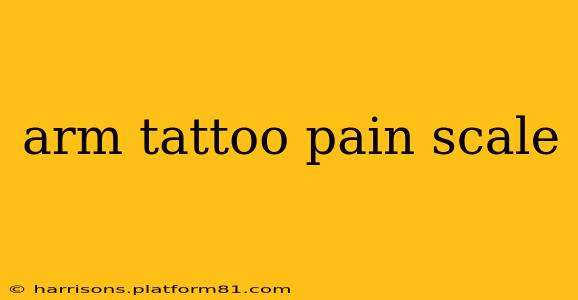Getting a tattoo is a deeply personal journey, a form of self-expression that leaves a lasting mark—literally. While the allure of stunning artwork is undeniable, the reality of the process includes the often-discussed element of pain. This guide aims to demystify the pain associated with arm tattoos, offering insights based on various factors and providing a clearer understanding of what to expect.
How Painful is an Arm Tattoo?
The pain of getting an arm tattoo is subjective and varies greatly depending on several key factors. There isn't a universally agreed-upon pain scale for tattoos, but many people describe the sensation as a combination of scratching, stinging, and burning. Some describe it as mildly uncomfortable, while others find it moderately painful. It's crucial to remember that everyone experiences pain differently.
What Factors Influence Arm Tattoo Pain?
Several factors contribute to the perceived pain level during an arm tattoo:
1. Location on the Arm:
- Inner Arm: Generally considered one of the least painful areas on the arm. The skin is relatively thin and has more fat, acting as a cushion.
- Outer Arm (Bicep/Tricep): Moderately painful. The skin is thicker and more muscular than the inner arm.
- Forearm: Pain tolerance varies along the forearm. The inner forearm tends to be less painful than the outer forearm, which can be more sensitive due to proximity to the bone.
- Elbow: Considered a more painful area because of the abundance of nerve endings and thin skin over the joint.
- Wrist: The wrist, similar to the elbow, is a sensitive area with many nerve endings and thin skin, resulting in a higher pain level.
- Shoulder: The shoulder can be quite painful, largely due to the bony prominence and proximity to nerves.
2. Tattoo Style and Technique:
- Fine Line Work: This style generally causes less pain due to the smaller needle size and lighter pressure.
- Bold Lines and Shading: Larger needles and deeper penetration often result in more pain.
- Color Packing: This can be more painful due to the repeated needle passes over the same area.
3. Individual Pain Tolerance:
Pain tolerance is highly personal. Factors like stress levels, previous pain experiences, and even menstrual cycles can significantly influence your pain perception during a tattoo session.
4. Artist's Technique:
A skilled and experienced tattoo artist understands how to minimize discomfort through their technique, needle depth, and speed. Finding an experienced and reputable artist is critical.
5. Aftercare:
Proper aftercare is vital for healing and minimizing discomfort. Following your artist's instructions meticulously will contribute to a smoother recovery and lessen any lingering sensitivity.
Is Getting an Arm Tattoo More Painful Than Other Body Parts?
Compared to other body parts, the arm is generally considered to be a relatively less painful area to get tattooed. Areas like the ribs, ankles, feet, groin, and inner thighs are often reported as being significantly more painful.
What Can I Do to Minimize Pain During a Tattoo Session?
- Choose a reputable and experienced tattoo artist: A skilled artist will make the experience as comfortable as possible.
- Communicate with your artist: Let them know if you're feeling any discomfort; they can adjust their technique as needed.
- Eat a good meal beforehand: Low blood sugar can increase sensitivity to pain.
- Stay hydrated: Proper hydration can help your body cope with the stress of the procedure.
- Consider pain relief methods: Over-the-counter pain relievers like ibuprofen can be taken before your appointment (always consult your doctor first).
Conclusion
The experience of arm tattoo pain is subjective and multifaceted. By understanding the factors that influence pain perception and taking proactive steps to prepare, you can approach your tattoo appointment with greater confidence and manage any discomfort effectively. Remember that the beautiful result is well worth the temporary discomfort for many individuals.
